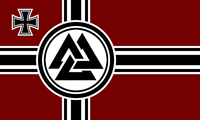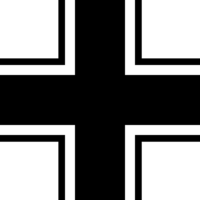Wehrmacht (Altenland): Difference between revisions
(Replaced content with "{{Delete}}") Tag: Replaced |
No edit summary |
||
| Line 1: | Line 1: | ||
{{ | {{Infobox national military | ||
|name = Reichswehr | |||
|native_name = Reich Defense | |||
|image =[[File:ValkistWarFlag.png|200px]] | |||
|caption = ''Reichskriegsflagge'', the war flag and naval ensign of the Reichswehr | |||
|image2 = [[File:Kaiserkreuz.png|200px]] | |||
|caption2 = Emblem of the ''Reichswehr'', the ''Kaiserkreuz'' | |||
|headquarters = [[Hochstadt]], [[Altenland]] | |||
|commander-in-chief = [[Martin Winter]] | |||
|minister = [[Bruno Graf von Scharnhorst]] | |||
|minister_title = Kriegsminister | |||
|commander = | |||
|commander_title = | |||
|branches = {{flagicon_image|WehrmachtHelmetDecal.png}}[[Heer (Altenland)|Heer]]<br>{{flagicon_image|WehrmachtHelmetDecal.png}} [[Luftwaffe (Altenland)|Luftwaffe]]<br>{{flagicon_image|WehrmachtHelmetDecal.png}} [[Kriegsmarine (Altenland)|Kriegsmarine]] | |||
|age = 18-35 | |||
|conscription = Limited | |||
|manpower_data = | |||
|manpower_age = | |||
|available = | |||
|fit = | |||
|reaching = | |||
|active = 900,000 | |||
|ranked = | |||
|reserve = 800,000 | |||
|deployed = | |||
|amount = | |||
|percent_GDP = | |||
|domestic_suppliers = | |||
|foreign_suppliers = | |||
|imports = | |||
|exports = | |||
|history = | |||
|ranks = [[Wehrmacht Ranks]] | |||
}} | |||
The '''''Wehrmacht''''' ("defense force") are the unified armed forces of [[Altenland|Valkist Altenland]]. It consists of the [[Heer (Altenland)|Heer]] (army), [[Luftwaffe (Altenland)|Luftwaffe]] (air force), and [[Kriegsmarine (Altenland)|Kriegsmarine]] (navy). The designation ''"Wehrmacht"'' replaced the previously used term ''Reichswehr'', which had earlier replaced the term ''[[Republikswehr]]'' and serves as the manifestation of the Valkist regime's efforts to rearm Altenland to a greater extent than the [[Treaty of Verdon]] permitted. | |||
After the [[Valkistiche Volkspartei|Valkists]] rose to power in 1928, one of [[Martin Winter]]'s most overt and audacious moves was to establish the ''Wehrmacht'', a modern and offensively capable fighting force. In his first few years in power, Winter moved to violate most of Altenland's military restrictions by reinstituting conscription, expanding the size of the armed forces well beyond 150,000, constructing tanks and submarines, and forming an air force, the ''Luftwaffe'', which was strictly forbidden by Verdon. This has required massive investment and defense spending on the arms industry. | |||
=Origin= | |||
===Etymology=== | |||
===Background=== | |||
=Valkist rise to power= | |||
=Personnel and recruitment= | |||
===Women in the Wehrmacht=== | |||
=Command structure= | |||
=Branches= | |||
===Army=== | |||
===Air Force=== | |||
===Navy=== | |||
=Theaters and campaigns= | |||
[[category:Altenland]] | |||
Revision as of 14:41, 18 December 2023
| Reichswehr | |
|---|---|
| Reich Defense | |
 Reichskriegsflagge, the war flag and naval ensign of the Reichswehr | |
 Emblem of the Reichswehr, the Kaiserkreuz | |
| Service branches | |
| Headquarters | Hochstadt, Altenland |
| Leadership | |
| Commander-in-Chief | Martin Winter |
| Kriegsminister | Bruno Graf von Scharnhorst |
| Personnel | |
| Military age | 18-35 |
| Conscription | Limited |
| Active personnel | 900,000 |
| Reserve personnel | 800,000 |
| Related articles | |
| Ranks | Wehrmacht Ranks |
The Wehrmacht ("defense force") are the unified armed forces of Valkist Altenland. It consists of the Heer (army), Luftwaffe (air force), and Kriegsmarine (navy). The designation "Wehrmacht" replaced the previously used term Reichswehr, which had earlier replaced the term Republikswehr and serves as the manifestation of the Valkist regime's efforts to rearm Altenland to a greater extent than the Treaty of Verdon permitted.
After the Valkists rose to power in 1928, one of Martin Winter's most overt and audacious moves was to establish the Wehrmacht, a modern and offensively capable fighting force. In his first few years in power, Winter moved to violate most of Altenland's military restrictions by reinstituting conscription, expanding the size of the armed forces well beyond 150,000, constructing tanks and submarines, and forming an air force, the Luftwaffe, which was strictly forbidden by Verdon. This has required massive investment and defense spending on the arms industry.